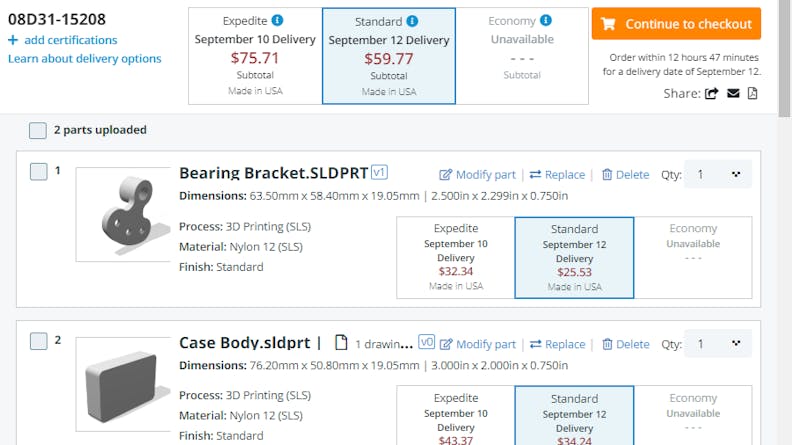Rapid prototyping is a modern method of product development that allows engineers to compress design timelines by iterating faster to reach a final production-ready design. The new design process has been enabled by modern manufacturing systems, such as Xometry’s on-demand platform, and transfers efficiency benefits through to an entire design-to-production workflow.
3D printing offers significant advantages for rapid prototyping parts. Sometimes it is used as a substitute to prototype CNC machined parts, urethane cast parts, or injection molded pieces. Ahead, read about the distinct advantages that rapid prototyping with 3D printing can bring to your projects.
Advantage 1: Speed
Rapid prototyping largely refers to parts that are produced through additive manufacturing (3D printing). Although some simple parts can be made within a week using CNC machining, sheet metal, or turning, 3D printed parts have consistently reduced lead times across a broader range of materials and geometries. Since a 3D printer takes data from a 3D CAD model and prints the file without any extra machine set-up time (such as those found in traditional manufacturing), any given design can be printed in hours.
A part under 4 inches in diameter may take around 4 hours to print, while a part under 8 inches in diameter may take 20. On average, this means most 3D printed parts can be ordered, printed, and delivered to your desk in under a week. With the increased speed of prototyping, projects can be launched sooner and products can move to market much faster.
Advantage 2: Affordability
3D printing can cost significantly less than the manufacturing processes traditionally used for prototyping, such as CNC machining. With the latter, there are additional costs associated with material procurement, programming tool paths, configuring a setup, running and monitoring the machine, and completing finishing work. With 3D printing, a file is sent to the printer, the machine interprets the CAD model data, prints it, and the finished part is removed from the printer for any finishing work like sandblasting.
Using 3D Printing for your Prototyping? Get our FREE SLA 3D Printing Design Guide
Depending on the complexity and size of your design, a part under 4” in diameter can cost less than $100
Advantage 3: Test a Full Range of Designs
Through rapid prototyping, engineers can test complex designs that would otherwise be costly and time-intensive to produce. In fact, 3D printing allows engineers to produce items that could not be produced with CNC machining or sheet metal fabrication without specialized tooling. Parts with thin walls, sharp corners, and areas inaccessible to milling tools can be easily produced with the layer-by-layer method of manufacturing used in rapid prototyping (hence the name, additive manufacturing).
Creating prototypes with varying part geometries can help designers understand the trade-offs between function and aesthetic during prototype testing. Once various prototypes are tested, engineers can pare down their design to the simplest form necessary to the function of the part.
Advantage 4: Part Consolidation
Rapid prototyping allows engineers to test a single part that, when manufactured for end-use, requires production as multiple parts and assembly. Consolidating multiple machined or fabricated parts in the prototyping process is not only cost-effective but allows engineers to explore additional designs and part function.
Additionally, some 3D printing processes such as Direct Metal Laser Sintering (DMLS), Selective Laser Sintering (SLS), HP Multi Jet Fusion (HP MJF), and Carbon DLS™ are suitable for end-use parts, so part consolidation in the prototyping and production stage can dramatically reduce overall costs during product development.
Advantage 5: Test Materials
3D printing allows designers to choose from a variety of materials that closely model the end-part material or that can perform similarly in the end-part environment. 3D printed materials range from Nylon 12, a material used in SLS and HP MJF, that can withstand a heat of over 300°F (149°C), to Aluminum AlSiMg, a metal composite that can withstand the stresses and temperatures typical of automotive component environments. Some 3D printing platforms offer over 200 combinations of materials, colors, and finishes from which to design custom parts.
Advantage 6: Increased Risk Mitigation
Being able to see a design in hand mitigates risk before a part is manufactured with costly production processes or before tooling is created. Since 3D printing is extremely cost-effective, less financial risk is borne upon a company if they decide to take a dramatically different design direction or simply continue iterating designs during the prototyping phase. Since rapid prototyping largely removes financial and time risk from the equation, trial and error testing can occur.
Making Rapid Prototyping Work for You
By choosing rapid prototyping, you can reduce your design-to-production timeline from months to weeks, pay 2-10 times less for prototypes, and test new materials, component geometries, and possibilities for your engineering project. Additionally, Xometry does not have any minimum order quantities, so you can choose 3D printing or other manufacturing services like CNC machining, injection molding, or urethane casting to build your components for rapid prototyping.
Xometry offers expedite options to speed up delivery for traditional manufacturing processes. Explore the capabilities of Xometry's 3D printing service to learn more.

.webp)




